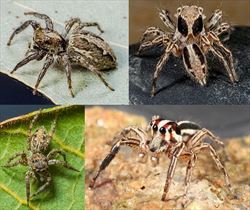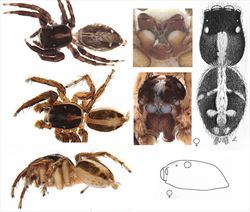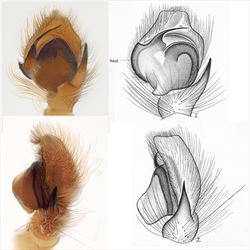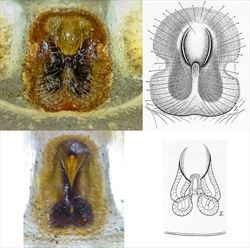
Examples of live Plexippus
Illustrator (and ©) I.R. Macaulay

Aspects of the general morphology of Plexippus
Illustrators (and ©) B.J. Richardson, M. Zabka (diag.)

Palp morphology of Plexippus
Illustrators (and ©) B.J. Richardson, M. Zabka (diag.)

Epigyne morphology of Plexippus
Illustrators (and ©) B.J. Richardson, M. Zabka (diag.)
Plexippus C.L. Koch, 1846
Taxonomy
Plexippus is found in tropical areas around the world, including Australia with three species; Plexipus paykullii, P. petersii and P. phyllus. The latter is known only from the holotype while the other two have extensive tropical distributions outside Australia. The genus elsewhere includes many described species. Evacin, Evawes and Thyene, all with Australian species, are other widespread genera belonging to the same old-world group. Further information on the genus and described species in Australia can be found in Richardson and Żabka (2017) and Whyte and Anderson (2017).
Description
Plexippus spp. are large spiders, ranging in body length from 7 to 10 mm. The carapace is high, rising to a peak at the posterior lateral eyes. The head, viewed from above, is pear-shaped, widest behind the posterior lateral eyes. The abdomen is ovate. Chelicerae have a single (unident) retromarginal tooth and two teeth on the promargin. The legs are long and slender, the first pair not much stronger than the others. There are strong spines on the tibiae and meta-tarsi of all legs.
The male’s palp has a short, narrow embolus arising on the distal or prolateral lateral side of the tegulum. The tegulum is wide and roundish with a large proximal lobe and a sclerotised keel on the lateral edge. The palpal tibia has a single, large, tapering apophysis with a sharp point.
The female’s epigyne has a distinctive hour-glass shape with a single atrium and two guides converging medially. The copulatory openings are in a median pouch at the anterior end of the atrium. The insemination ducts lead postero-laterally to the spermathecae. The pear-shaped spermathecae are located immediately posterior to the atrium.
Biology
Plexippus is found on grass and other vegetation, as well as in and around houses, often climbing walls. In temperate areas overseas, Plexippus has been found in hothouses. Plexippus paykullii has been used extensively in studies of spider behaviour and genetics (see references in Richardson and Żabka, 2017).
Distribution
This cosmotropical genus occurs widely in coastal areas of Western Australia, the Northern Territory and Queensland. It is also found on offshore islands, including the Ashmore and Cartier Reef and the Great Barrier Reef. The holotype of P. phyllus is from New South Wales.
References
Davies, V.T. & Żabka, M. 1989, Illustrated keys to the genera of jumping spiders (Araneae: Salticidae) in Australia. Memoirs of the Queensland Museum 27, 189-266.
Richardson, B.J. & Żabka, M. 2017. Salticidae. Arachnida: Araneomorphae. Canberra, Australian Faunal Directory. Australian Biological Resources Study, at https://biodiversity.org.au/afd/taxa/SALTICIDAE.
Whyte, R. and Anderson, G. 2017. A field guide to the spiders of Australia. Clayton: CSIRO Publishing 451pp.
* The information sheet should be read in the context of the associated diagrams and photographs. Diagrams explaining anatomical terms can be found in the ‘Salticidae’ pictures at the beginning of the list of genera.